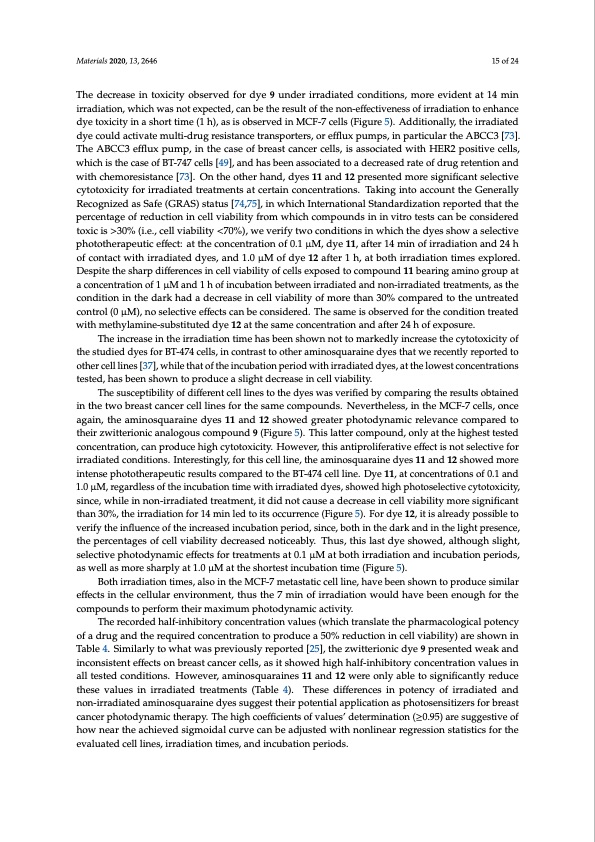
PDF Publication Title:
Text from PDF Page: 015
Materials 2020, 13, 2646 15 of 24 The decrease in toxicity observed for dye 9 under irradiated conditions, more evident at 14 min irradiation, which was not expected, can be the result of the non-effectiveness of irradiation to enhance dye toxicity in a short time (1 h), as is observed in MCF-7 cells (Figure 5). Additionally, the irradiated dye could activate multi-drug resistance transporters, or efflux pumps, in particular the ABCC3 [73]. The ABCC3 efflux pump, in the case of breast cancer cells, is associated with HER2 positive cells, which is the case of BT-747 cells [49], and has been associated to a decreased rate of drug retention and with chemoresistance [73]. On the other hand, dyes 11 and 12 presented more significant selective cytotoxicity for irradiated treatments at certain concentrations. Taking into account the Generally Recognized as Safe (GRAS) status [74,75], in which International Standardization reported that the percentage of reduction in cell viability from which compounds in in vitro tests can be considered toxic is >30% (i.e., cell viability <70%), we verify two conditions in which the dyes show a selective phototherapeutic effect: at the concentration of 0.1 μM, dye 11, after 14 min of irradiation and 24 h of contact with irradiated dyes, and 1.0 μM of dye 12 after 1 h, at both irradiation times explored. Despite the sharp differences in cell viability of cells exposed to compound 11 bearing amino group at a concentration of 1 μM and 1 h of incubation between irradiated and non-irradiated treatments, as the condition in the dark had a decrease in cell viability of more than 30% compared to the untreated control (0 μM), no selective effects can be considered. The same is observed for the condition treated with methylamine-substituted dye 12 at the same concentration and after 24 h of exposure. The increase in the irradiation time has been shown not to markedly increase the cytotoxicity of the studied dyes for BT-474 cells, in contrast to other aminosquaraine dyes that we recently reported to other cell lines [37], while that of the incubation period with irradiated dyes, at the lowest concentrations tested, has been shown to produce a slight decrease in cell viability. The susceptibility of different cell lines to the dyes was verified by comparing the results obtained in the two breast cancer cell lines for the same compounds. Nevertheless, in the MCF-7 cells, once again, the aminosquaraine dyes 11 and 12 showed greater photodynamic relevance compared to their zwitterionic analogous compound 9 (Figure 5). This latter compound, only at the highest tested concentration, can produce high cytotoxicity. However, this antiproliferative effect is not selective for irradiated conditions. Interestingly, for this cell line, the aminosquaraine dyes 11 and 12 showed more intense phototherapeutic results compared to the BT-474 cell line. Dye 11, at concentrations of 0.1 and 1.0 μM, regardless of the incubation time with irradiated dyes, showed high photoselective cytotoxicity, since, while in non-irradiated treatment, it did not cause a decrease in cell viability more significant than 30%, the irradiation for 14 min led to its occurrence (Figure 5). For dye 12, it is already possible to verify the influence of the increased incubation period, since, both in the dark and in the light presence, the percentages of cell viability decreased noticeably. Thus, this last dye showed, although slight, selective photodynamic effects for treatments at 0.1 μM at both irradiation and incubation periods, as well as more sharply at 1.0 μM at the shortest incubation time (Figure 5). Both irradiation times, also in the MCF-7 metastatic cell line, have been shown to produce similar effects in the cellular environment, thus the 7 min of irradiation would have been enough for the compounds to perform their maximum photodynamic activity. The recorded half-inhibitory concentration values (which translate the pharmacological potency of a drug and the required concentration to produce a 50% reduction in cell viability) are shown in Table 4. Similarly to what was previously reported [25], the zwitterionic dye 9 presented weak and inconsistent effects on breast cancer cells, as it showed high half-inhibitory concentration values in all tested conditions. However, aminosquaraines 11 and 12 were only able to significantly reduce these values in irradiated treatments (Table 4). These differences in potency of irradiated and non-irradiated aminosquaraine dyes suggest their potential application as photosensitizers for breast cancer photodynamic therapy. The high coefficients of values’ determination (≥0.95) are suggestive of how near the achieved sigmoidal curve can be adjusted with nonlinear regression statistics for the evaluated cell lines, irradiation times, and incubation periods.PDF Image | Photophysicochemical Light Antiproliferative vs cancer

PDF Search Title:
Photophysicochemical Light Antiproliferative vs cancerOriginal File Name Searched:
materials-13-02646-v2.pdfDIY PDF Search: Google It | Yahoo | Bing
Cruise Ship Reviews | Luxury Resort | Jet | Yacht | and Travel Tech More Info
Cruising Review Topics and Articles More Info
Software based on Filemaker for the travel industry More Info
The Burgenstock Resort: Reviews on CruisingReview website... More Info
Resort Reviews: World Class resorts... More Info
The Riffelalp Resort: Reviews on CruisingReview website... More Info
| CONTACT TEL: 608-238-6001 Email: greg@cruisingreview.com | RSS | AMP |